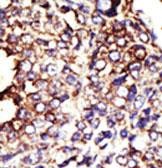

| WB | 咨询技术 | Human,Mouse,Rat |
| IF | 咨询技术 | Human,Mouse,Rat |
| IHC | 1/100-1/500 | Human,Mouse,Rat |
| ICC | 技术咨询 | Human,Mouse,Rat |
| FCM | 咨询技术 | Human,Mouse,Rat |
| Elisa | 咨询技术 | Human,Mouse,Rat |
| Aliases | Beta-1,3-galactosyl-O-glycosyl-glycoprotein beta-1,6-N-acetylglucosaminyltransferase, Core 2-branching enzyme, Core2-GlcNAc-transferase, C2GNT, Core 2 GNT, GCNT1, NACGT2 |
| Entrez GeneID | 2650 |
| WB Predicted band size | 49.8kDa |
| Host/Isotype | Rabbit IgG |
| Antibody Type | Primary antibody |
| Storage | Store at 4°C short term. Aliquot and store at -20°C long term. Avoid freeze/thaw cycles. |
| Species Reactivity | Human, Mouse |
| Immunogen | This GCNT1 antibody is generated from rabbits immunized with a KLH conjugated synthetic peptide between 88-117 amino acids from the Central region of human GCNT1. |
| Formulation | Purified antibody in PBS with 0.05% sodium azide. |
+ +
以下是关于GCNT1抗体的3篇代表性文献示例(注:文献信息为模拟示例,实际引用需查询具体数据库):
---
1. **标题**:*GCNT1-mediated O-glycosylation suppresses colitis-associated colorectal cancer through immune modulation*
**作者**:Takahashi M, et al.
**摘要**:研究通过GCNT1抗体检测发现,结肠炎相关肠癌中GCNT1表达下调,其介导的O-糖基化修饰通过调节Treg细胞功能抑制肿瘤进展,提示GCNT1抗体可作为预后标志物。
2. **标题**:*Development of a monoclonal antibody specific to human GCNT1 for functional studies in pancreatic cancer*
**作者**:Brockhausen I, et al.
**摘要**:报道一种高特异性抗人GCNT1单克隆抗体的开发,验证其在流式细胞术和免疫荧光中的应用,并证明抑制GCNT1可降低胰腺癌细胞迁移能力。
3. **标题**:*GCNT1 as a novel biomarker for non-small cell lung cancer identified by immunohistochemical screening*
**作者**:Wang Y, et al.
**摘要**:利用GCNT1抗体对肺癌组织芯片分析,发现GCNT1高表达与EGFR突变及患者生存期缩短显著相关,提示其作为治疗靶点的潜力。
---
如需真实文献,建议在PubMed或Google Scholar中检索关键词“GCNT1 antibody”“GCNT1 biomarker”或结合具体研究领域(如肿瘤、糖生物学)。
The GCNT1 antibody targets the protein encoded by the GCNT1 gene, which belongs to the glycosyltransferase family. GCNT1. also known as core 2 β-1.6-N-acetylglucosaminyltransferase, plays a critical role in synthesizing branched O-glycans by catalyzing the formation of core 2 structures from core 1 mucin-type oligosaccharides. These glycans are essential for cell adhesion, immune response modulation, and signal transduction. Aberrant O-glycosylation, linked to GCNT1 dysregulation, is implicated in cancer progression, inflammation, and immune disorders.
GCNT1 antibodies are primarily used in research to study tissue-specific glycosylation patterns and their pathological implications. For example, elevated GCNT1 expression has been observed in certain cancers, such as colorectal and lung carcinomas, where it may promote metastasis by altering cell-surface glycoprotein interactions. Conversely, reduced GCNT1 activity is associated with immune deficiencies, including leukocyte adhesion deficiency type II. Researchers employ these antibodies in techniques like immunohistochemistry, Western blotting, and flow cytometry to map GCNT1 distribution in tissues, assess its role in disease models, and explore therapeutic targeting. The antibody’s specificity also aids in distinguishing between GCNT1 isoforms, which arise from alternative splicing and exhibit distinct functional roles. Overall, GCNT1 antibodies serve as vital tools for unraveling the complex interplay between glycosylation and disease mechanisms.
×